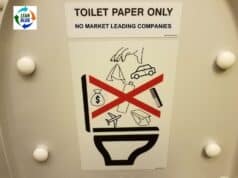Stepping away from serious issues, let's talk about things that can really get heated — like washers and dryers (rim shot). Sorry for the bad joke… plus, I'm a drummer, so I love the chance to do a nice rim shot to punctuate a joke.
The New York Times had a piece of hard hitting journalism about home appliances last week (“For the Dishwasher's Sake, Go Easy on the Detergent“). I don't think this was front page news, but there were elements of Lean concepts that might apply in the home. It has been a while since I've had a good “Everyday Lean” post.
I often use the informative and fun DVD, “Toast Kaizen” when doing basic Lean concepts training in hospitals — it's a fun, simple lesson for learning to identify waste and initiate process improvement ideas in Bruce Hamilton's kitchen. Then, on to the pharmacy! In our discussions, it's inevitable that somebody brings up issues of dishwasher “standardized work,” namely variation and disagreements that can take place between husband and wife — my home included!
The article gives many lessons, including:
The No. 1 sin, according to repair people and appliance experts, seems to be adding too much soap to washing machines or dishwashers.
“Nobody thinks they use too much soap,” said Vernon Schmidt, who has been a repairman for almost 35 years…
We're probably not too careful in my house about how much soap we add to the clothes washer. With the kitchen dishwasher, we might be guilty of that last extra squeeze that might be waste — except when we use the pre-measured tablets of soap… assuming those are an optimized size (it could be too much soap, if the manufacturer decided the “right” amount looked “too small” to the consumer).
“Most people use 10 to 15 times the amount of soap they need, and they're pouring money down the drain,” Mr. Schmidt said.
It's human nature, I think, to think more is better. Back to the workplace, if a little inventory is good, more is better (goes conventional wisdom). A little automation is good, more must be better. The article points out that “more is better” certainly doesn't apply to fabric softener sheets. If one is good, more isn't better… they can melt and gum up the works.
On the theory that if one is good, five must be better, people throw in a bunch of the sheets. Those liquefy when the dryer gets hot and can gum up the dyer, becoming “almost like tar and feathers,” Mr. Manganiello said.
Too much soap is bad for the machine and bad for your clothes (and probably bad for the environment):
Too much detergent can make your clothes stiff and shorten the life of your machine. An excess of soap can also cause a buildup of mold and mildew, said Jill Notini, a spokeswoman for the Association of Home Appliance Manufacturers, a trade group.
So, if we have an “evidence-based household,” I guess we would look at the data and research and use best practices… which brings me to the issue that my wife and I disagree with — rinsing dishes before the dishwasher.
I've tried making the case that the dishwasher manual (a rare product manual I've read) says that a modern dishwasher can handle most food residue and that pre-rinsing (or pre-scrubbing) wastes a lot of water in the sink. I still can't “get buy in” on the household standardized work! :-) I'm trying to convince her that she's “overprocessing,” but I guess I'm not a good change agent after all — no dice!
Now I have a publication (the “Gray Lady,” the New York Times!) to back me:
Also, remove baked on food and large chunks, but for the most part, everyone I spoke to said prerinsing dishes before putting them in the dishwasher was not only unnecessary, it wasted thousands of gallons of water and could actually result in dirtier dishes.
And there's this counter-intuitive tidbit, that leaving a bit of dirt on actually leads to cleaner dishes:
“The soap needs something to work against to get the dishes clean,” said Lou Manganiello, who owns Household Appliance Service in Hawthorne, N.Y., and has been doing repairs for 23 years.
That reminds me of the counterintuitive things that you often discover in a lean transformation.
The one tip about dishwasher loading that I've learned (and adopted) from my wife is not putting a number of spoons all head down in the same part of the utensil tray — they stick together (“spooning,” if you will) and they soap and water spray can't get to them… you get dirty spoons.
The article also has tips for doing what you might call “preventive maintenance” or TPM in the Lean vernacular — how to maintain a dryer by properly cleaning out lint (hint: it's not just the lint tray that needs attention… I should learn and adopt this practice).
I'm obsessed over having a “lean household,” so it's OK to me that my wife and I have different practices, that there's not fully consistent standardized work in the kitchen. I can live with that!
Maybe this gives some fun examples you can use in more serious and more meaningful settings at work… or we can share stories about loving kitchen disagreements.
Please scroll down (or click) to post a comment. Connect with me on LinkedIn.
Let’s build a culture of continuous improvement and psychological safety—together. If you're a leader aiming for lasting change (not just more projects), I help organizations:
- Engage people at all levels in sustainable improvement
- Shift from fear of mistakes to learning from them
- Apply Lean thinking in practical, people-centered ways
Interested in coaching or a keynote talk? Let’s talk.
Join me for a Lean Healthcare Accelerator Trip to Japan! Learn More










At my house, I’m in charge of the dishwasher and never pre-rinse the plates before putting them in…
That’s because of a practical experience when I did it the first two times with and without rinsing and seen no much difference (maybe the dirtier the plates were and better was the result I’ve obtained…).
So why waste my time and water on rinsing if there is no significant change?
You may want to take it to the next level – don’t use the dishwasher at all – like we are used to in this part of the world. You can control the soap use very finely and no electricity wasted on this. It also forces us to use as minimal dishes as possible to reduce the labor. But we seem to be moving the western way with washing clothes however.
.-= Jayadeep Purushothaman ´s last blog ..Composting Update =-.
I have been told by my better half that in our dishwasher not pre-rinsing plates leads to food chunks in glasses that are in top drawer. I haven’t seen any evidence of this, but haven’t dared to push this issue further :)
When washing clothes, the end result depends on 4 variables, found in Sinner’s Circle. Temperature, Time, Mechanical action and Chemical action. Correct ratio between these variables depends on equipment at hand, used detergents and type of textiles and dirtines. Most significant of these is amount of mechanical action ie. how much products move during washing process, more movement -> better end result. Of course, these things are rarely adjustable in consumer products.
.-= Panu Kinnari ´s last blog ..Mahtuuko kongressiin yksi lean ajattelija? =-.
Mark, I also found that you can save a lot of money and reduce the calcium deposits by just putting vinegar in your rinsing agent reservoir. Keeps my dishes shiny and the gunck out of my machine.
I like this post!
.-= Monique ´s last blog ..How To Use SigmaXL for Design of Experiments (DoE) [VIDEO] =-.
We’re shopping for dishwashers now for the first time in a few years. After 50+ years it seems like the manufacturers have finally looked at what people actually put in their dishwashers and erred on the side of batch flexibility. The instruction manuals always show how the racks can nicely accommodate eight standard place settings. I can’t remember the last time we washed anything like that. The height of the top racks even adjusts on some of the new models.
Still, in the listening to the customer category, if stainless on the exterior is higher end, stainless on the interior must indicate even better quality, despite the extra, leak prone seams and noise dampening that aren’t necessary with plastic tubs. But that, and hidden buttons, are apparently what consumers pine for, or have been influenced to want these days.
.-= David Drickhamer ´s last blog ..Gary Kaplan, MD – Lean in Healthcare: Leadership =-.
Thanks for the comments, everyone. Panu, you are a smart man :-) Some issues are not worth pushing at home…
And then there is the Homer Simpson approach (from last week’s episode, viewable for U.S. readers):
http://hulu.com/w/3vqf
Comments are closed.